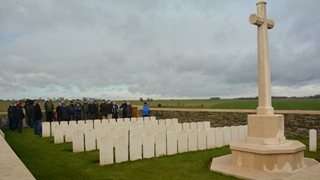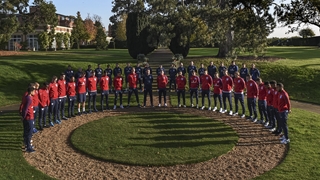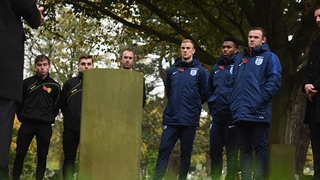
2020's Remembrance Sunday will be like no other.
As images of the Cenotaph are beamed all over the globe from a deserted Whitehall, myriad thoughts of the fallen from conflicts all over that very same world will include those individuals who represented their country not only on the battlefield but on the football field, too.
The first World War was supposed to be the war to end all wars, yet was followed within a generation by the second. What World War I did end, though, was a way of life that had existed for most of the previous hundred years. When war was declared in August 1914 it initially had little or no effect on normal life – people continued to go to work, children to school and the English Football League season had just started. Indeed, the league continued to its conclusion, with Everton crowned champions and Derby winning Division Two while the FA Cup Final, at Old Trafford in April 1915, saw Sheffield United beat Chelsea 3-0.
But, long before those entries in the football records were written, the full horror of industrial-scale war was already indelibly etched on the national psyche. Political figure William Joynson Hicks was swept along with a patriotic fervour that gripped a nation hoodwinked into thinking 'it will all be over by Christmas' – little did anyone know the festive season in question would not come until 1918.
Hicks founded the Footballers' Battalion and England international centre-half Frank Buckley – the 376th man to represent the Three Lions – was the first to join. Contractual difficulties prevented professional footballers enlisting but amateurs such as Vivian Woodward were not so encumbered.
Woodward had an astonishing record for England. He won 23 caps between 1903 and 1911 and scored 29 times to set a record as the best-goals-per-game England international with 1.26 – a record that stands to this day. After joining the Footballers' Battalion he reached the rank of captain and served on the Western Front, where he was wounded in 1916. Those injuries ended his football career but he survived the war, dying in 1954 at the age of 74. Another enlisted amateur, Evelyn Lintott, wasn't so fortunate.
Surrey-born Lintott played for Woking, Plymouth Argyle, Queens Park Rangers, Bradford City and Leeds City. Capped seven times by England between 1908 and 1909, he died in 1916 on the first day of the Battle of the Somme.
Jimmy Conlin was an exceptionally-talented footballer and only the second player to be transferred for over £1,000, when he signed for Manchester City in July 1906. Another distinguished mark in his career came earlier than year, when he became Bradford's first England international, winning what would be his one and only cap in a defeat by Scotland.
Conlin retired from football before the outbreak of war but, when it came, he enlisted in the Highland Light Infantry. Jimmy died at the Third Battle of Ypres – also known as Passchendael – in 1917, aged 35. He has no known grave but, like 546 other servicemen, Private Conlin 26447 is commemorated on the Nieuport memorial, Belgium.
Eddie Latheron helped Blackburn Rovers win the Football League title in 1912 and again in 1914 – the last pre-war campaign. He won two England caps and scored the second goal in a 4-3 victory over Wales in 1913. Eddie died at the Battle of Passchendael in October 1917. He is one of 14 players commemorated at St. George's Park as part of the Woodland Trust's Centenary Woods project to mark 100 years since the outbreak of World War I.
Frank Booth was a Manchester City player who won his only England cap in the 1-1 draw with Ireland at Ayresome Park in 1905. Booth signed for Bury in 1906 and later rejoined City, in 1911. He joined the army as a Gunner with the Royal Garrison Artillery in April 1917 and was posted to France the following March. He returned to Britain in February 1919 but died four months later of an inoperable heart tumour and was buried in a military grave in Denton, Manchester.
There is a parallel between the unique position England footballers hold and the mercifully-small numbers of that elite group who have fallen in the service of their country. Despite few internationals being killed on active service, that wasn't the end of a casualty list that was much longer.
Major Buckley kept copious records of the men in his charge. When he published those figures in the 1930s he noted that, of the original 600-strong Footballers' Battalion, more than 500 were dead – either killed in action or from wounds suffered.
Mercifully again, 'only' two England internationals died in military service during World War II. Tom Cooper, who played 430 league games in his 16-year career with Port Vale, Derby County and Liverpool, won 15 caps between 1927 and 1934, including four as captain. He joined the Royal Military Police after the outbreak of the second World War but, in June 1940, his despatch motorcycle collided with a lorry and he was killed. The incident caused the British government to pass legislation that despatch riders were thenceforward not allowed to ride their motorcycles without wearing a crash helmet.
Herbie Roberts won four league titles and the FA Cup with Arsenal when Herbert Chapman's side dominated English football but was capped just once, in the 2-0 loss to Scotland on 28 March 1931. His career was ended by injury in 1937 and, when war broke out, he enlisted into the Royal Fusiliers. He died, aged 39, of erysipelas on 17 June 1944 while serving as a lieutenant.
At this point it is important to note that the pauses in fixtures during both conflicts will have robbed a number of players of potential international recognition. After Fanny Walden became England's 382nd player in April 1914, there was a four-and-a-half-year wait for the 383rd, Joe Smith, to make his debut. The second World War led to an even longer period without international matches, with more than seven years between the first appearances of Leslie Smith and Frank Swift – players 654 and 655 respectively.
England did, though, play a number of wartime international games – one 'military international' in May 1916, four 'victory internationals' throughout 1919 and many more from 1939 to 1946.
Harry Goslin is not listed among the 1,256 men who have represented England at senior level. He did, though, win four 'caps' playing for his country in wartime matches and was the epitomy of a one-club man, spending his entire career with Bolton Wanderers and scoring 23 goals in just over 300 games.
But the big story behind Harry, football and World War II is this: on 8 April 1939, before Bolton's fixture with Sunderland, he stood in the middle of the Burnden Park pitch and, with microphone in hand, informed the assembled fans that the entire Wanderers team were to enlist immediately after the match. Bolton won 2-1 and the squad, true to their captain's word, did indeed sign up at the local Territorial Army hall.
Harry was promoted to lieutenant for his bravery at Dunkirk, where he destroyed four Panzer tanks. In 1942 he and the rest of the Wanderers served under General Montgomery in north Africa, but it was during the allied invasion of Italy that Harry was to lose his life. On 14 December 1943, a mortar shell exploded under a tree near where he had set up his observation post. He was hit in the back by shrapnel and wood and, though he fought for his life, he died four days later.
Despite the thankful absence of England players from the horrendous casualty list between 1939 and 1945, many professional footballers did enlist and quite a number of famous internationals served their country in uniform, most of them as physical training instructors.
Stanley Mortensen, the Blackpool centre-forward, almost lost his life when the Wellington bomber on which he was an air-gunner crashed near Lossiemouth. Two of the crew died and the navigator lost a leg, while Mortensen went on to score four times on his England debut in a 10-0 win over Portugal at the age of 25. He would win a total of 25 caps and rack up 23 goals – totals that would've certainly been higher had his first cap arrived earlier.
Other notable England internationals who served in the military between 1939 and 1945 included Ted Drake (five caps and six goals from 1934 to 1938), Stanley Matthews (54 caps and 11 goals from 1934 to 1957), Tom Finney (76 caps and 30 goals from 1946 to 1958), Joe Mercer (five caps from 1938 to 1939), Cliff Britton (nine caps from 1934 to 1937), Tommy Lawton (23 caps and 22 goals from 1938 to 1948), Billy Wright (105 caps and three goals from 1946 to 1959) and Stan Cullis (12 caps from 1937 to 1939).
How many more appearances could those who represented England both on the pitch and at war have made? As our locked-down nation falls silent on Remembrance Sunday and Armistice Day, we will think of them all.
Whether Arras or Arnhem, the Somme or Dunkirk; or the skies over Germany or the waves of the cold, cold seas; the England internationals – and others – who died for their country. We will not forget.
320. James Conlin (born 6 July 1881, died 23 June 1917)
331. Evelyn Henry Lintott (born 2 November 1883, died 1 July 1916)
373. Edwin Gladstone Latheron (born 22 December 1887, died 14 October 1917)
521. Thomas Cooper (born 9 April 1905, died 25 June 1940)
558. Herbert Roberts (born 19 February 1905, died 17 June 1944)














